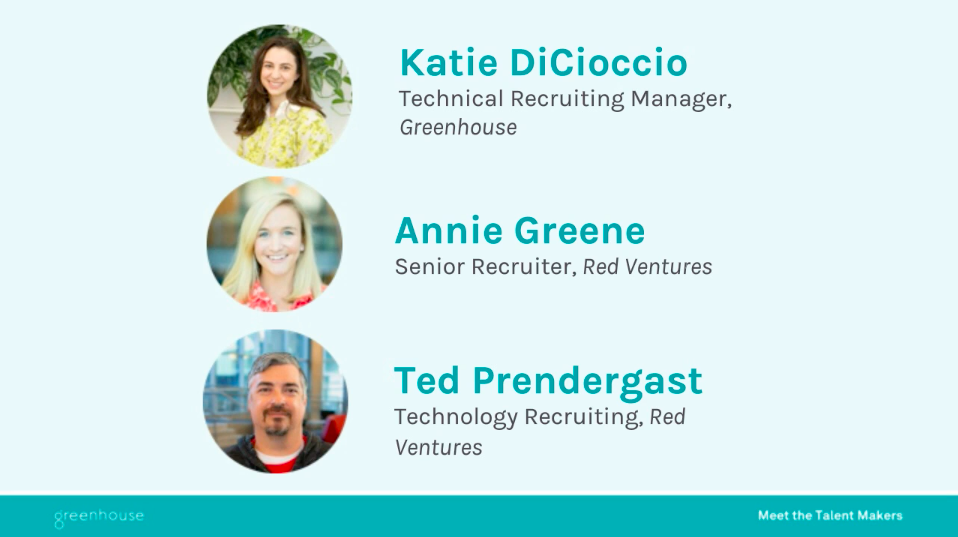How to be an expert sourcer: a conversation between Red Ventures & Greenhouse

4 mins, 50 secs read time
Ever feel like you’re playing hide-and-seek with candidates? When you know they’re out there, but you just can’t seem to find them? Good news – LinkedIn found that around 90% of global professionals are open to hearing about opportunities. The trick, of course, is to be thoughtful about who you approach, when you reach out to them and how you do it. Our recent “Sourcing Unwrapped: How to Be an Expert Sourcer” webinar centered around the art and science of sourcing.
In this fireside chat, Greenhouse’s Technical Recruiting Manager Katie DiCioccio led a discussion with Senior Recruiter Annie Greene and Technology Talent Acquisition Manager Ted Prendergast from Red Ventures. Read on for a few highlights from their conversation or watch the on-demand webinar here.

Empowering Employee Referrals
Employee referrals are a significant source of quality candidates at both Red Ventures and Greenhouse. In 2018, 19% of Greenhouse hires and nearly 30% of Red Ventures hires came from referrals. Annie is a firm believer in the power of referrals, saying that no one is better equipped than current employees to understand who would be a good fit and what it takes to be successful in a role.
“We believe that someone already in the role is going to best be able to refer someone else to the role.” – Annie Greene, Senior Recruiter, Red Ventures
But what’s the trick to actually getting your employees involved in the referral process? Bribing them with food, of course! (We’re only slightly kidding here.) Red Ventures has seen a lot of success with their “LinkedIn Lunch” and “LinkedIn Latte” sessions. The recruiting team will choose a handful of employees for each session and go through each person’s network ahead of time so they’ll already have a shortlist of prospects. Each employee is paired with a recruiter who will work through the list, asking questions like, “How well do you know this person?” “Would you recommend them?” “Do you want to reach out to them or would you prefer someone from the recruiting team to do it?”
Not only do these conversations enlighten recruiters about prospective candidates, but they also help employees from other teams better understand the sourcing process. This means that over time, employees feel empowered to actually go through their network independently and make recommendations to the recruiting team.
At Greenhouse, we’ve been intentional about creating a robust referral program. Some of our key tenets include rewarding engagement and choosing not to offer financial incentives. Check out The 6 Elements of a Winning Employee Referral Program to learn more.
Next-Level Social Media Sourcing Strategies
Now that the recruiting team at Red Ventures has trained their employees to mine their own LinkedIn networks so effectively, they’re able to look at next-level sourcing strategies to reach even more candidates through social media. Ted explains that their social media strategy on platforms like Medium, Slack, GitHub and Quora is twofold: it’s a way to share employer branding talent to attract candidates, and it’s also a way to directly engage with prospective candidates.
Recruiters will share original content related to branding, employee stories and company culture at Red Ventures and then see who likes and shares these posts. Over time, they’ll like and share posts by these people as well, gradually building relationships. Similarly, by asking questions and starting conversations, Red Ventures’ recruiters can create a list of potential candidates who are knowledgeable and engaged. These tactics take sustained time and effort, but as Ted explains, “Even if you get one hire on one platform, it’s completely paying for itself.”
Ted also recommends meeting candidates where they are. While LinkedIn gets around 260 million active users per month, Instagram has around 1 billion active users in the same timeframe. Ted’s team has found that it can be beneficial to connect with prospects on multiple platforms, because they may tend to be more active or keep their contact information up to date on Instagram but not LinkedIn, for example. The key is to always be considerate of when you’re reaching out to candidates and what you’re saying.
“With all social media, you have to be smart and professional. Be mindful of how you’re messaging people and when you’re messaging people.” – Ted Prendergast, Technology Talent Acquisition Manager at Red Ventures
Don’t Forget About Former Candidates
If you’ve been hard at work sourcing for the past few years, chances are you’ve already got a great pool of past candidates. Annie says when a new role opens up, she’ll often start sourcing within Greenhouse. Consider how previous prospects or candidates might fit in with your current talent needs. For example, Annie recently had an entry-level opening, so she reached out to former candidates who came in through Red Ventures’ on-campus recruiting efforts. By sending targeted outreach messages to this specific group of former candidates, she was able to make two hires.
Katie shares a similar approach that’s worked well at Greenhouse. Recruiters will make a note of candidates who were promising but perhaps lacked skills in a specific area. They’ll follow up with these candidates six months or a year later to see if they’ve expanded their skill set and find out if they’re interested in revisiting a conversation with Greenhouse. This works especially well for recurring roles on the sales and engineering teams. Read more of Katie’s tips and tricks for keeping in touch with previous candidates here.
You know those promising prospects and candidates are out there – now you’ve got a few tricks up your sleeve to help you find them faster!
Looking for even more sourcing strategies and tactics? Check out the full webinar to hear Annie, Ted and Katie’s tips on diversity sourcing, in-person events and how to use Greenhouse for sourcing success.
